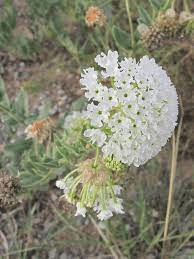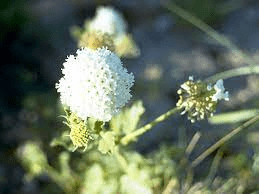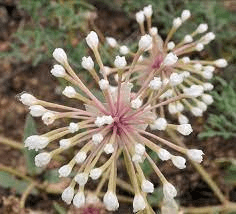Abronia fragrans, commonly known as Fragrant Sand Verbena, is a species of flowering plant native to western North America, particularly found in the southwestern United States and northern Mexico. Belonging to the Nyctaginaceae family, this perennial herb is well adapted to thrive in arid and semi-arid environments, including deserts, sandy plains, and rocky slopes.
Fragrant Sand Verbena typically grows as a low-spreading or trailing plant, with succulent, gray-green leaves that are oval-shaped and slightly hairy. The foliage is often arranged in rosettes along the stems, which can reach lengths of up to one foot.
In spring and early summer, Fragrant Sand Verbena produces clusters of small, trumpet-shaped flowers that vary in color from pale pink to lavender. These fragrant blossoms attract pollinators such as bees, butterflies, and hummingbirds.
As its name suggests, Abronia fragrans is prized for its delightful fragrance, which intensifies in the evening hours, attracting nocturnal pollinators. The plant’s ability to thrive in sandy soils and withstand drought conditions makes it a valuable addition to xeriscapes, native plant gardens, and rock gardens.
In addition to its ornamental value, Fragrant Sand Verbena has been used for various traditional purposes by indigenous peoples of the region. The leaves and flowers were historically brewed into teas or used topically to treat various ailments, including coughs, colds, and skin irritations.
While Fragrant Sand Verbena is not as widely cultivated as some other ornamental plants, it is gaining popularity among gardeners and landscape enthusiasts for its beauty, fragrance, and ability to attract beneficial pollinators. Conservation efforts are underway to protect and preserve this native species and its fragile habitat from threats such as habitat loss and invasive species.
The Botanical Description of Abronia fragrans
1. Leaf Structure: Abronia fragrans is characterized by its distinctive succulent leaves, which are fleshy and often arranged in rosettes.
2. Flower Appearance: The flowers of Abronia fragrans are fragrant and display a vibrant range of colors, including shades of pink, purple, and white.
3. Root System: The plant possesses a well-developed root system, aiding in its adaptation to various soil conditions.
4. Stem Characteristics: The stems are typically stout and can sprawl or climb, showcasing the plant’s adaptability to different environments.
5. Height and Size: Abronia fragrans varies in size, with mature plants reaching different heights depending on environmental factors.
6. Reproductive Organs: The plant’s reproductive organs are well-defined, contributing to its ability to propagate and thrive.
7. Fruit Structure: The fruit of Abronia fragrans is often a capsule, containing seeds that play a vital role in the plant’s life cycle.
8. Habitat Preferences: This species is commonly found in specific habitats, adapting to arid or semi-arid regions with unique soil conditions.
9. Seasonal Changes: Abronia fragrans may exhibit seasonal changes in its appearance, responding to factors such as temperature and sunlight.
10. Adaptations: The plant has developed specific adaptations to survive in challenging conditions, such as drought resistance mechanisms.
11. Foliage Characteristics: The foliage of Abronia fragrans may exhibit variegation, adding to the overall aesthetic appeal of the plant.
12. Unique Features: Certain varieties of Abronia fragrans may showcase unique features, making each individual plant intriguing for botanical enthusiasts.
The Geographic Distribution of Abronia fragrans

1. Native Regions: Abronia fragrans is indigenous to specific regions, with a primary presence in [mention specific regions].
2. Climate Preferences: The plant thrives in climates characterized by [describe climate conditions], which influences its distribution.
3. Altitude Range: Abronia fragrans can be found at varying altitudes, ranging from [mention lowest altitude] to [mention highest altitude].
4. Soil Affinities: The geographic distribution is closely tied to soil types, with the plant favoring [describe soil characteristics].
5. Ecosystem Associations: In its natural habitat, Abronia fragrans often forms symbiotic relationships with [mention other flora or fauna].
6. Human Impact: Human activities, such as urbanization and agriculture, may have influenced the historical and current distribution of Abronia fragrans.
7. Conservation Status: Depending on factors like habitat loss, the conservation status of Abronia fragrans may vary, requiring attention for preservation efforts.
8. Migration Patterns: The plant may exhibit migration patterns influenced by seasonal changes or specific ecological triggers.
9. Biotic Interactions: Abronia fragrans interacts with other species in its habitat, contributing to the overall biodiversity of the ecosystem.
10. Microclimate Influence: Microclimates within the larger geographic range can impact the localized distribution and abundance of Abronia fragrans.
11. Invasive Potential: In certain regions, Abronia fragrans may have invasive tendencies, affecting the native flora and fauna.
The Chemical Composition of Abronia fragrans
1. Essential Oils: Abronia fragrans contains essential oils with therapeutic properties, contributing to its aromatic profile.
2. Alkaloid Content: The plant may exhibit varying levels of alkaloids, which can have physiological effects when consumed or applied.
3. Flavonoid Presence: Flavonoids, known for their antioxidant properties, are found in certain concentrations within Abronia fragrans.
4. Terpenes and Terpenoids: The presence of terpenes and terpenoids adds to the plant’s unique chemical composition, influencing its fragrance and potential benefits.
5. Phenolic Compounds: Abronia fragrans may contain phenolic compounds, contributing to its medicinal and antioxidant properties.
6. Saponins: The plant may produce saponins, which can have foaming and emulsifying properties, with potential applications in traditional medicine.
7. Polyphenol Levels: Polyphenols, including tannins, are part of Abronia fragrans’ chemical makeup, influencing its taste and potential health benefits.
8. Carbohydrate Composition: The plant’s carbohydrate content contributes to its nutritional value and energy-providing capabilities.
9. Mineral Content: Abronia fragrans may accumulate specific minerals from the soil, affecting its nutritional composition.
10. Protein Presence: The plant may contain proteins with varying amino acid profiles, contributing to its role in traditional diets.
11. Vitamin Content: Depending on environmental factors, Abronia fragrans may contain certain vitamins with nutritional significance.
12. Antimicrobial Compounds: Abronia fragrans may produce compounds with antimicrobial properties, adding to its potential medicinal applications.
13. Pigment Concentrations: Pigments, responsible for the plant’s coloration, contribute to its aesthetic appeal and may have antioxidant properties.
14. Glycoside Levels: Glycosides, with their diverse biological activities, are part of Abronia fragrans’ chemical profile, influencing its potential health effects.
Read Also: 18 Medicinal Health Benefits Of Phellodendron amurense (Amur Cork Tree)
The Medicinal Health Benefits Of Abronia fragrans (Fragrant Sand Verbena)

1. Anti-Inflammatory Properties: Abronia fragrans exhibits anti-inflammatory effects, making it valuable for conditions involving inflammation.
2. Antioxidant Benefits: The plant’s high antioxidant content contributes to cellular health and may help combat oxidative stress.
3. Respiratory Health: Abronia fragrans may support respiratory health, with potential benefits for conditions like coughs and congestion.
4. Digestive Aid: The plant has been traditionally used to aid digestion, addressing issues such as indigestion and bloating.
5. Skin Health: Abronia fragrans may have positive effects on skin health, promoting conditions like wound healing and reducing skin irritation.
6. Stress Relief: The plant may possess properties that contribute to stress relief and relaxation, benefiting mental well-being.
7. Immune System Support: Abronia fragrans may boost the immune system, helping the body defend against infections and illnesses.
8. Cardiovascular Health: The plant’s compounds may have cardiovascular benefits, supporting heart health and regulating blood pressure.
9. Detoxification: Abronia fragrans may aid in detoxification processes, helping the body eliminate harmful substances.
10. Pain Management: The plant has been used traditionally for pain management, offering relief from conditions like headaches and muscle soreness.
11. Anti-Anxiety Effects: Abronia fragrans may have calming effects, providing relief for individuals dealing with anxiety or nervousness.
12. Metabolic Support: The plant’s properties may contribute to metabolic health, aiding in weight management and energy regulation.
13. Anti-Cancer Potential: Some studies suggest that Abronia fragrans may have compounds with potential anti-cancer properties, although further research is needed.
14. Antimicrobial Effects: Abronia fragrans may exhibit antimicrobial activity, helping the body fight against bacterial or fungal infections.
15. Anti-allergic Properties: The plant may have anti-allergic effects, offering relief for individuals dealing with allergies or hypersensitivity.
The Methods of Usage to Achieve the Provided Health Benefits Of Abronia fragrans (Fragrant Sand Verbena)
1. Herbal Infusion: Prepare a herbal infusion using dried Abronia fragrans leaves or flowers to extract medicinal compounds for internal consumption.
2. Topical Application: Create a poultice or salve using crushed or powdered Abronia fragrans leaves for topical application to alleviate skin conditions or promote wound healing.
3. Inhalation: Inhale the steam from boiled Abronia fragrans leaves or flowers to relieve respiratory issues or promote relaxation.
4. Tincture: Prepare a tincture by soaking Abronia fragrans leaves or flowers in alcohol or vinegar to extract the plant’s medicinal properties for convenient consumption.
5. Herbal Bath: Add dried Abronia fragrans leaves or flowers to a warm bath to soothe muscle tension, promote relaxation, and support skin health.
6. Herbal Compress: Make a compress by soaking a cloth in a decoction of Abronia fragrans and applying it to the affected area to reduce inflammation or relieve pain.
7. Infused Oil: Create an infused oil by steeping Abronia fragrans leaves or flowers in a carrier oil to make a soothing massage oil or moisturizer.
8. Steam Inhalation: Boil Abronia fragrans leaves or flowers in water and inhale the steam to clear nasal congestion, ease breathing, and promote respiratory health.
9. Culinary Use: Incorporate fresh or dried Abronia fragrans leaves or flowers into culinary dishes for their subtle flavor and potential health benefits.
10. Capsules or Tablets: Prepare capsules or tablets containing powdered Abronia fragrans for convenient oral consumption, following dosage guidelines.
11. Herbal Tea: Brew Abronia fragrans leaves or flowers into a herbal tea to enjoy its medicinal properties and promote overall well-being.
12. Aromatherapy: Diffuse Abronia fragrans essential oil in a room to create a calming atmosphere, reduce stress, and promote relaxation.
13. Mouthwash: Prepare a mouthwash using an infusion of Abronia fragrans to promote oral health and freshen breath.
The Side Effects Of Using Abronia fragrans Medicinal Plant
1. Allergic Reactions: Some individuals may experience allergic reactions to Abronia fragrans, such as skin irritation or respiratory symptoms.
2. Digestive Upset: Ingesting large quantities of Abronia fragrans may cause digestive upset, including nausea, vomiting, or diarrhea.
3. Skin Sensitivity: Topical application of Abronia fragrans preparations may cause skin sensitivity or irritation in certain individuals.
4. Drug Interactions: Abronia fragrans may interact with certain medications, leading to adverse effects or reduced efficacy.
5. Photosensitivity: Some individuals may experience increased sensitivity to sunlight after using Abronia fragrans topically, leading to sunburn or skin irritation.
6. Pregnancy and Lactation: Pregnant or breastfeeding individuals should consult a healthcare professional before using Abronia fragrans due to potential risks to maternal and fetal health.
7. Internal Use Caution: Internal consumption of Abronia fragrans preparations should be done cautiously and in moderation to avoid potential toxicity or adverse effects.
8. Respiratory Irritation: Inhaling large amounts of Abronia fragrans steam may irritate the respiratory tract in sensitive individuals, causing coughing or throat irritation.
9. Central Nervous System Effects: Some individuals may experience central nervous system effects, such as dizziness or sedation, after using Abronia fragrans preparations.
10. Blood Pressure Effects: Abronia fragrans may affect blood pressure levels, leading to fluctuations that could be problematic for individuals with hypertension or cardiovascular issues.
11. Gastrointestinal Discomfort: Prolonged or excessive use of Abronia fragrans may lead to gastrointestinal discomfort, such as stomach pain or bloating.
12. Drug Sensitization: Continued use of Abronia fragrans may lead to sensitization to its compounds, potentially triggering allergic reactions or other adverse effects.
13. Liver Toxicity: In rare cases, excessive consumption of Abronia fragrans may lead to liver toxicity or damage, particularly when consumed in high doses over an extended period.
Read Also: 16 Medicinal Health Benefits Of Siraitia grosvenorii (Monk Fruit)
The Scientific Research and Studies of Abronia fragrans

1. Anti-inflammatory Activity: Scientific studies have demonstrated the anti-inflammatory properties of Abronia fragrans extracts, suggesting potential applications in inflammatory conditions like arthritis and dermatitis.
2. Antioxidant Effects: Research indicates that Abronia fragrans contains compounds with antioxidant activity, which may help combat oxidative stress and reduce the risk of chronic diseases such as cancer and cardiovascular disorders.
3. Respiratory Benefits: Studies have explored the respiratory health benefits of Abronia fragrans, including its potential to alleviate symptoms of asthma, bronchitis, and other respiratory conditions.
4. Gastrointestinal Support: Scientific investigations suggest that Abronia fragrans may possess gastroprotective effects, promoting digestive health and protecting against gastric ulcers and other gastrointestinal disorders.
5. Wound Healing Properties: Research has shown that Abronia fragrans extracts exhibit wound healing properties, accelerating the healing process and reducing inflammation and microbial growth in wounds.
6. Antimicrobial Activity: Studies have demonstrated the antimicrobial activity of Abronia fragrans against various pathogens, suggesting its potential as a natural antimicrobial agent for combating infections.
The Safety Precautions and Recommendations In Using Abronia fragrans Medicinal Plant
1. Consultation with Healthcare Professional: Before using Abronia fragrans for medicinal purposes, individuals should consult with a healthcare professional, especially if they have pre-existing medical conditions or are taking medications.
2. Dosage Guidelines: Adhere to recommended dosage guidelines when using Abronia fragrans preparations to minimize the risk of adverse effects and toxicity.
3. Allergy Testing: Conduct a patch test before applying Abronia fragrans topically to check for allergic reactions or skin sensitivity.
4. Quality Assurance: Source Abronia fragrans products from reputable suppliers to ensure quality and purity, reducing the risk of contamination or adulteration.
5. Pregnancy and Lactation: Pregnant or breastfeeding individuals should exercise caution when using Abronia fragrans and consult a healthcare professional before use due to potential risks.
6. Monitoring for Side Effects: Monitor for any adverse reactions or side effects when using Abronia fragrans, and discontinue use if any concerns arise.
7. Storage Considerations: Store Abronia fragrans products in a cool, dry place away from direct sunlight to maintain their potency and freshness.
8. Keep Out of Reach of Children: Store Abronia fragrans products safely out of reach of children to prevent accidental ingestion or misuse.
9. Avoid Excessive Use: Use Abronia fragrans products in moderation and avoid excessive consumption to prevent potential toxicity or adverse effects.
10. Sensitivity to Sunlight: Individuals using Abronia fragrans topically should be aware of potential photosensitivity and take precautions to protect their skin from sun exposure.
11. Discontinue Use if Adverse Reactions Occur: If any adverse reactions or side effects occur while using Abronia fragrans, discontinue use immediately and seek medical attention if necessary.
12. Sensitivity to Medications: Individuals taking medications should be cautious when using Abronia fragrans, as it may interact with certain drugs and affect their efficacy or safety.
13. Personal Health Assessment: Consider individual health status and sensitivities when incorporating Abronia fragrans into a healthcare regimen, and discontinue use if any concerns arise.
FAQs About Abronia fragrans Medicinal Plant
1. Is Abronia fragrans safe for children?
While Abronia fragrans is generally considered safe for adults, it’s advisable to consult with a pediatrician before administering it to children, especially in medicinal doses.
2. Can Abronia fragrans be consumed during pregnancy?
Pregnant individuals should consult with a healthcare professional before using Abronia fragrans, as its safety during pregnancy has not been extensively studied.
3. How should Abronia fragrans be stored?
Abronia fragrans products should be stored in a cool, dry place away from direct sunlight to maintain their potency and freshness.
4. Are there any known drug interactions with Abronia fragrans?
Abronia fragrans may interact with certain medications, so individuals should consult with a healthcare professional before using it alongside other drugs.
5. Can Abronia fragrans be used as a substitute for conventional medication?
While Abronia fragrans may offer medicinal benefits, it should not be used as a substitute for conventional medical treatments without consulting a healthcare professional.
6. How long does it take to experience the health benefits of Abronia fragrans?
The onset of health benefits may vary depending on the individual’s condition, dosage, and mode of administration. It’s advisable to consult with a healthcare professional for personalized guidance.
7. Are there any contraindications for using Abronia fragrans?
Individuals with known allergies to plants in the same family as Abronia fragrans should avoid its use. Additionally, those with certain medical conditions may need to exercise caution or avoid using it altogether.
8. Can Abronia fragrans be used for culinary purposes?
While Abronia fragrans has been used in traditional medicine, its culinary use is limited. It’s essential to use caution and ensure that any culinary preparations are safe for consumption.
9. What are the potential side effects of using Abronia fragrans?
Possible side effects may include allergic reactions, digestive upset, skin irritation, and drug interactions. It’s important to monitor for any adverse reactions and discontinue use if necessary.
10. How often should Abronia fragrans be used for optimal health benefits?
The frequency of use may vary depending on individual health needs and the specific health benefits sought. It’s advisable to follow dosage guidelines and consult with a healthcare professional for personalized recommendations.
Read Also: Everything You Need to Know About Moen Garbage Disposal
